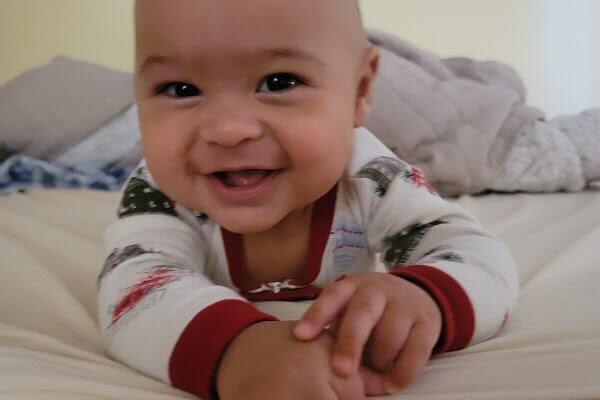By Nancy Gottesman
In May, something curious happened on amazon.com’s bestseller list. A little humor book reached #1 months before its scheduled release date—thanks to a wholly unintended viral campaign by parents of young children. The title? Go the [Bleep] to Sleep, written by Adam Mansbach, an obviously exasperated and exhausted father. The title may be crude, but it clearly resonated with legions of parents whose infants and toddlers have trouble getting to sleep and staying asleep. “When babies aren’t sleeping well,” says sleep researcher Douglas Teti, PhD, a professor of human development, psychology and pediatrics at Pennsylvania State University in University Park, “it can be more stressful to the parents than it is to the child.”
Sleep is essential for physical and emotional health. If your child doesn’t get enough, she’s at higher risk for childhood obesity and poorer cognitive functioning. (Your health also suffers from a lack of z’s.) Here are the recommended numbers of total sleep hours (including naps and nighttime sleep) by age:
• Newborns: 16 to 20 hours
• 1 to 4 months: 14 to 15 hours
• 6 to 12 months: 13 to 14 hours
• 12 to 24 months: 12 hours
Sleep patterns among children in this age group vary a lot, and they learn to sleep through the night at different points in development. Some may sleep more during the day than at night, while others take short naps and sleep mostly at night. These sleep styles may have a genetic component or they may be a result of family lifestyle. Up to 30 percent of healthy young children have difficulty falling and staying asleep at night—which explains why Mansbach’s little sleep book struck such a far-reaching chord. If your child is one of them, we’re betting that you share the author’s frustration.
Fortunately, pediatric sleep scientists who’ve been investigating why some young children fall and stay asleep more easily than others do have discovered specific parenting behaviors that can significantly improve a child’s sleep habits. Try the behavioral interventions that follow, and our experts say that both you and your child will be getting a good night’s rest in one to two weeks—tops.
(Note: Some babies and toddlers have medical conditions—such as snoring, allergies or reflux—that impede sleep. To make sure your child’s sleep problems are not health-related, make an appointment with your pediatrician.)
0–24 months
Develop a Three-Step Routine
“Creating a bedtime routine is a simple change that can dramatically improve both the child’s sleep and the mother’s well-being,” says Jodi A. Mindell, PhD, associate director of the Sleep Center at Children’s Hospital of Philadelphia, whose research bears this out. In one study, Mindell examined 206 babies, 7 to 18 months old, who had sleep problems such as three or more nightly wakings, waking up for 60 minutes or longer each night, or having a total daily sleep duration of less than nine hours. Mothers were asked to institute a three-step bedtime procedure: bath, massage and quiet activity (such as cuddling or singing), with lights out within 30 minutes of the end of the bath. The results were astonishing: Infants increased their longest continuous sleep period by two hours and decreased the number and duration of their night wakings. The toddlers in the study (18 to 36 months old) whose parents followed a three-step bedtime routine had similar success, and upped their longest sleep period by one hour and reduced their number of night wake-ups.
Young children with bedtime routines have lower stress levels, says Mindell. Reduced stress leads to fewer arousals and enhanced sleep quality. “Mother also gets more sleep, which can make a huge difference in her energy and mood,” she adds. You don’t have to duplicate the study’s three steps of bath-massage-cuddling for a routine to work. You can try music-book-rocking or bath-singing-cradling—whatever works best for you and your family. Just make sure your routine doesn’t take longer than 30 minutes. Then, put your infant on his back to sleep.
It’s Not What You Do, but How You Do It (aka Be Emotionally Available)
Your emotional state at bedtime may be even more important to your child’s sleep than the bath-book-song routine itself. In a recent issue of the Journal of Family Psychology, scientists videotaped the sleep habits of 1- to 24-month-old children as well as their mothers’ behaviors at bedtime. The children whose moms were the most emotionally receptive not only went to sleep more easily, but also reduced their number of night wakings. For example, when the mother of a 6-month-old cuddled and responded promptly to the baby’s attempts to speak at bedtime, her baby fell asleep quickly and woke up fewer times during the night. On the other hand, the 24-month-old whose mom tried to force him to stay still while she read him a book—despite clear signs that he’d lost interest—got up and left the room four times before eventually going to sleep and then woke up numerous times during the night.
“Bedtime can be an emotional time of day,” says study author Teti. “It heralds a time when an infant or toddler will be separating from his parents—and some children find this separation stressful.” Which is why your emotional availability is so vital. When you are sensitive to your baby’s signals to interact, your baby understands that it’s safe to fall asleep and that you’ll be there for him. “This helps him feel secure,” says Teti. “Because he trusts his sleep environment, if he wakes up, he’ll be more likely to go back to sleep on his own.” However, if you’re anxious or impatient to get the bedtime routine over with, you can’t be sensitive to your child’s need for your attention and affection. This, in turn, will only make your child anxious and reluctant to fall and stay asleep. Is it really any surprise that calm, secure babies and toddlers sleep better than worried ones? The same can be said of parents!
NEXT: BE CONSISTENT
{pagebreak}
Above All Else, Be Consistent
After the bedtime routine, put your child in her bed. Don’t kid yourself: The first few times you try to institute these behavior changes, your child is likely to cry. It’s okay to “allow her to cry for a few minutes,” says Bobbi Hopkins, MD, a pediatric neurologist/sleep medicine physician in the Texas Children’s Hospital Sleep Center in Houston, Texas. “Check in and make sure she’s okay, but limit physical contact.” If you cave in and offer one more hug, story or nursing-feed, your child will never learn to comfort herself. Instead, she’ll become more dependent on your help for getting to sleep.
Do the same thing when she wakes up in the middle of the night. If you’ve been feeding or rocking your baby back into slumber, she’ll expect this every night—and you’ll never get any rest. By 6 months old, a child no longer needs a nocturnal feeding. When she wakes, wait a few minutes to see if she will return to sleep. If the crying continues, simply go in and check to make sure she’s safe, then leave. You may have to check in multiple times the first few nights you institute these changes. Your child will eventually learn that you will always be there when needed—and that feedings, books and cuddles aren’t going to happen in the middle of the night anymore. “But you must be consistent in your responses every night,” stresses Hopkins. “If you give in or change the routine or only try these techniques for one or two nights, it will take a lot longer to establish new sleep habits.”
Lighting helps to establish your infant’s biological clock. Keep lights bright during your child’s waking hours and dim the lights an hour before bedtime. At naptime, shut the blinds and use the same 1-2-3 bedtime-routine activities, but for no longer than 20 minutes. Check in if your child cries, but then leave again. If you remain steadfast when instituting these changes, you’ll see rapid improvement in four to 14 nights, say experts. Remember that illnesses, vacations and other out-of-the-ordinary situations can gum up your good work, so be prepared for small setbacks from time to time. You’ll need to reteach your child, but the second time around won’t take as long or be as draining. “If you do the same thing every night at the same time, over and over again, your child will learn to go to sleep by himself,” assures Hopkins. “And everybody in the family will feel better.”
How much sleep your baby should be getting, and what you can do to make it happen.




